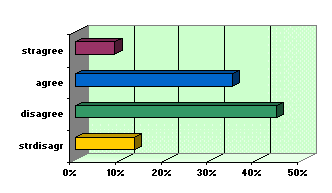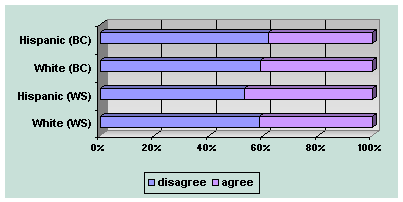Measures of San Antonio’s Social Capital—Social Cohesion
By Darla Norton, Research Associate, Arturo Vega, Ph.D., Associate Professor and Rubén O. Martinez, Ph.D., Professor.
Issue:
This issue brief--the sixth and final in a series of analyses that have examined social capital in Bexar County (San Antonio,) Texas--examines social cohesion at the community level. One measure of a community’s social capital is its level of social cohesion or how well members of a community perceive themselves to be connected or part of the larger community. Previous analyses of social cohesion suggest that it is “a stronger predictor of the perceived quality of life in a community than the community's income or educational level.”[i] These investigations of social capital also report that “residents of more diverse communities are more likely to be personally isolated, claim fewer friends and confidants, spend less time socializing with friends and relatives, and have less sense of community with their friends.”
How does our community compare? What is the level of social cohesion in San Antonio, Texas? Are there significant variations in levels of social cohesion among key demographic groups that make up the community? For example, do Latinos and African Americans in San Antonio have lower levels of cohesion relative to others (inner city, poor, women, lower and higher educated, non-Latino ethnic and racial members)? This brief focuses on these questions.
Data And Methods:
Data for this study were collected during the San Antonio Survey 2003 (SAS 2003), which was conducted during the weeks of October 12-28th, 2003.[ii] Responses are from a random probability sample of the general population of adults 18 years of age and older in Bexar County, (San Antonio) Texas, with listed phone numbers. A split sample design produced 423 responses from a random sample of individuals within the county, and an additional oversample of 136 respondents living on San Antonio’s West Side for a total of 559 respondents.[iii]
To measure social cohesion the following question was asked: “Some people believe that San Antonio is a city strongly divided on the basis of race and ethnicity. Others argue that residents of San Antonio are more alike that they are different, suggesting a mostly unified city. How strongly would say you agree or disagree with the belief that San Antonio is a divided city? (DIVIDED CITY)” [iv]
Findings:
When SAS respondents were asked, “how strongly would say you agree or disagree with the belief that San Antonio is a divided city?” nearly half the respondents indicated that they disagree (44.1%), in addition one in eight (12.8%) respondents indicating that strongly disagreeing with the proposition. On the other hand, thirty four (34.5) percent of the respondents said they agreed with the proposition and fewer than one in eleven (8.6%) reporting that they strongly agree that San Antonio is a city divided by race (see Figure 1). Collectively and in general, over four in ten (43.1%) respondents perceive the community to be divided by race and ethnicity, while nearly six in ten (56.9%) disagree that the community is divided.
Table 1 presents social cohesion by demographic determinants. Income level and race/ethnicity were the only factors that were statistically significant, albeit weakly associated with the measure of social cohesion. Fifty-five percent of respondents in the lowest income categories (less $30,000 annually), for example, either agree or strongly agree that San Antonio is a city divided by race and ethnicity. In contrast, strong majorities of respondents in middle and higher income categories either disagree or strongly disagree with the proposition. Examining the responses by the race and ethnicity of the respondents revealed that nearly seven in ten African Americans believe San Antonio is a city divided by race compared to only four in ten Anglos and Hispanics. Interestingly, Anglos and Hispanics are closer in their perceptions than their African American counterparts. There were no significant differences in the distribution of perceptions among respondents when examined by age, whether respondents lived inside or outside Loop 410, educational levels, sex or geographic location (Westside respondents versus Bexar respondents).
Figure 1: Responses to the DIVIDED CITY Proposition
 |
Table 2 presents social cohesion by social capital determinants. Here the only statistically significant although weak association was between those respondents who agreed that San Antonio is a city divided by race and ethnicity and their levels of overall general trust. Slightly over four in ten (42.5%) of the respondents who disagreed with the divided city proposition, for example, also expressed the view that most “people can be trusted.” In contrast, slightly over a quarter (27.3%) of the respondents who agreed with the divided city proposition held the same level of trust. In addition, nearly half (48.9%) the respondents who agreed with the divided city proposition felt that one “can’t be too careful” in trusting people compared to thirty-eight percent who disagreed that San Antonio is a divided city.
To test whether ethnicity or geographic residency affected respondent’s perceptions, the social cohesion question was examined by race/ethnicity, controlling for geographic location. Figure 2 shows there is no significant differences between Hispanics and Anglos living on the West Side and the rest of Bexar County in their agreement that San Antonio is a city divided by race and ethnicity.
Discussion:
These survey findings suggest that levels of social cohesion in San Antonio are slightly mixed and significantly related to income and race/ethnicity. Low income and African Americans San Antonians, in particular, express considerably “less connectedness” compared to others in Bexar County. In addition, social cohesion was found only to be weakly associated with the trust determinant of social capital as measure in the 2003 SAS. This latter finding suggests independence between perceptions of community cohesion and perceptions of individual indicators of social capital.
Table 1: Social Cohesion by Demographic Determinants
| Disagree | Agree | Chi.Sq. | Sig | CramersV | Gamma | |
| AGE | ||||||
| 18-29 | 53.3% | 46.7% | 6.54 | n/s | 0.12 | -0.01 |
| 30-39 | 58.5% | 41.5% | ||||
| 40-49 | 50.5% | 49.5% | ||||
| 50-64 | 64.8% | 35.2% | ||||
| 65+ | 50.9% | 49.1% | ||||
| INCOME | ||||||
| $0-29,999k | 45.3% | 54.7% | 10.83 | 0.01 | 0.17 | -0.28 |
| $30-59,999k | 56.7% | 43.3% | ||||
| $60,000k + | 66.3% | 33.7% | ||||
| LOOP | ||||||
| Inside | 56.9% | 43.1% | 0.03 | n/s | 0.01 | -0.02 |
| Outside | 57.7% | 42.3% | ||||
| RACETH | ||||||
| White | 58.9% | 41.1% | 8.87 | 0.01 | 0.14 | |
| Hispanic | 57.5% | 42.5% | ||||
| African Amer | 31.3% | 68.8% | ||||
| DEGREE | ||||||
| <HS | 59.7% | 40.3% | 2.37 | n/s | 0.07 | -0.03 |
| High School | 54.5% | 45.5% | ||||
| Some Coll | 52.6% | 47.4% | ||||
| Bachelors | 57.7% | 42.3% | ||||
| Graduate | 63.3% | 36.7% | ||||
| GENDER | ||||||
| Male | 59.4% | 40.6% | 1.32 | n/s | 0.05 | 0.10 |
| Female | 54.5% | 45.5% | ||||
| WESTSIDE | ||||||
| Westside | 52.7% | 47.3% | 1.57 | n/s | 0.05 | 0.12 |
| Bexar | 58.6% | 41.4% |
Table 2: Social Cohesion by Social Capital Determinants
| Disagree | Agree | Chi.Sq. | Sig | CramersV | Gamma | |
| TrustAll | ||||||
| Trusted | 42.5% | 27.3% | 12.91 | 0.01 | 0.16 | 0.23 |
| Can't | 38.1% | 48.9% | ||||
| Depends | 19.4% | 23.8% | ||||
| Friends | ||||||
| Less Freq | 53.3% | 46.7% | 2.65 | n/s | 0.07 | -0.15 |
| Frequently | 60.6% | 39.4% | ||||
| Visit Neigh | ||||||
| Less Freq | 56.1% | 43.9% | 0.06 | n/s | 0.01 | -0.02 |
| Frequently | 57.1% | 42.9% | ||||
| Visit Diff Race | ||||||
| Less Freq | 55.6% | 44.4% | 0.23 | n/s | 0.02 | -0.05 |
| Frequently | 57.8% | 42.2% |
Table 2: Social Cohesion by Social Capital Determinants (continued)
| Religious | ||||||
| Not Relig | 54.7% | 45.3% | 0.58 | n/s | 0.03 | -0.07 |
| Religious | 58.1% | 41.9% | ||||
| Vote | ||||||
| No Vote | 53.7% | 46.3% | 0.34 | n/s | 0.03 | -0.07 |
| Vote | 57.1% | 42.9% | ||||
| Volunteer | ||||||
| Less Freq | 54.6% | 45.4% | 0.64 | n/s | 0.04 | -0.07 |
| Frequently | 58.1% | 41.9% | ||||
| Org. Meeting | ||||||
| Less Freq | 56.4% | 43.6% | 0.00 | n/s | 0.00 | 0.00 |
| Frequently | 56.7% | 43.3% | ||||
| Public Meeting | ||||||
| Less Freq | 56.5% | 43.5% | 0.00 | n/s | 0.00 | 0.01 |
| Frequently | 56.1% | 43.9% |
Figure 2: DIVIDED CITY by Race/Ethnicity and Geographic Location
 |
Notes
[i] Saguaro Seminar on Civic Engagement in America. 2001
[ii] The SAS 2003 is an annual survey conducted by UTSA students in research methods courses in sociology, criminal justice, kinesiology and public administration, in conjunction with The Culture and Policy Institute. The survey provides students with experience in survey research and an opportunity to measure the attitudes and perceptions of San Antonians on topics of the day. Juanita Firestone, Professor, Department of Sociology, is the principal investigator; Richard Harris, Professor, Department of Sociology, and Arturo Vega, Associate Professor, Department of Public Administration, are co-principal investigators.
[iii] The standard error for the entire sample, including the additional sample from the Westside, is +/- 4.1% with a confidence level of 95%. The SAS 2003 incorporated several questions from the Saguaro Seminar’s “Social Capital Community Benchmark Survey Short Form 2001.” The authors acknowledge the Seminar for its generosity in sharing the short form on line. www.ksg.harvard.edu/saguaro/pdfs/socialcapitalshortform.pdf
[iv] Divided City was coded 1 'strongly disagree' 2 'disagree' 3 'agree' 4 ‘strongly agree’ and was recoded for our analysis into 3, 4=1 ‘agree’ and 1,2=0 ‘disagree’.